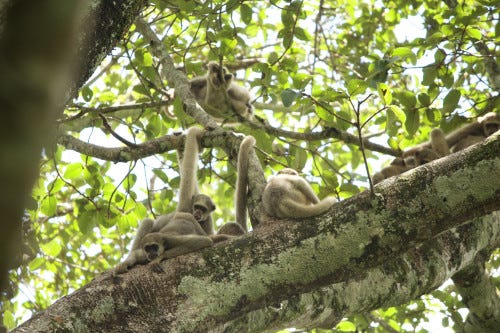Endangered Northern Muriqui Monkeys: A Delicate Ecological Balance in Brazil’s Atlantic Forest
A Legacy of Growth Amid Looming Risks

The northern muriqui monkey (Brachyteles hypoxanthus), a peaceful and egalitarian primate native to Brazil’s Atlantic Forest, stands as a beacon of both conservation success and caution. Once teetering on the brink of extinction with a population of just 50 individuals in 1982, decades of dedicated research and protection swelled their numbers to an impressive 356 by 2015. Yet, despite this growth, a new study published in Ecology1 reveals that this fragile recovery remains at the mercy of environmental stressors and abrupt mortality events, such as disease and habitat changes.

Led by Dr. Karen Strier of the University of Wisconsin–Madison and Dr. Anthony Ives, a population dynamics specialist, the research underscores how unpredictable ecological challenges can undermine long-term conservation gains.
The Fragile Rebound of a Rare Primate
Muriquis, often dubbed "hippie monkeys" for their gentle nature and cooperative social structure, inhabit some of the last remnants of Brazil’s once-vast Atlantic Forest. These highly endangered monkeys are protected by Brazilian law, but their survival depends on a precarious balance of stable reproduction rates, sufficient habitat, and the absence of major threats.

In the early 2010s, conservation efforts seemed to be paying off.
“By 2015, the population was thriving, showing exponential growth,” Strier notes.
Based on extensive field data collected over 33 years, Dr. Ives created a predictive model suggesting the population could reach a stable carrying capacity of 500 individuals.
Unforeseen Challenges: Drought and Disease
The optimism of these projections was short-lived. In 2014, a severe two-year drought gripped the region, followed by a yellow fever outbreak in 2016 that devastated the muriqui population. The monkeys’ mortality rate spiked, slashing their numbers and reshaping their demographic structure.
“Our data imply that environmental stressors such as reduced food availability or climate stress could have exacerbated the impact of the disease,” Strier explains.
When updated models factored in the sharp population decline between 2016 and 2022, the long-term carrying capacity plummeted to just 200 individuals. This grim scenario assumes no further catastrophic events—a risky assumption as climate change intensifies droughts and other stressors.
The Role of Long-Term Research in Conservation
Strier’s work exemplifies the importance of multi-decade studies in understanding and safeguarding endangered species.
“If you had stopped data collection in 2015, you’d assume everything was fine,” Ives notes. “But long-term monitoring revealed the vulnerabilities lurking beneath the surface.”
By tracking individual monkeys, researchers identified trends in reproduction, mortality, and social dynamics. These insights offer vital clues about the underlying pressures affecting muriqui survival and provide a foundation for future conservation strategies.
A Path Forward for Muriqui Conservation
For Brazil’s conservationists, the stakes are high. Dr. Leandro Jerusalinsky, head of the National Center for Research and Conservation of Brazilian Primates, emphasizes the value of Strier’s work.
“This research provides actionable insights into the threats these animals face and helps guide our conservation strategies.”
Key priorities include improving habitat quality, creating corridors between isolated muriqui populations, and mitigating threats like disease and habitat loss. Climate change further complicates these efforts, with warmer, drier conditions expected to reduce forest productivity and food availability.
Looking ahead, the data collected at Strier’s research site could inform strategies for other muriqui populations and even other primates facing similar challenges.
Hope in the Face of Uncertainty
Despite the mounting challenges, the study serves as a reminder of what sustained conservation efforts can achieve.
“Even in the face of adversity, this research gives us hope,” Jerusalinsky says. “It highlights the resilience of nature and the critical importance of science in crafting effective conservation policies.”
The northern muriquis, with their cooperative social bonds and remarkable recovery, are a testament to what can be achieved through dedicated stewardship. Yet, their story also underscores the fragility of life on the edge of extinction—and the urgent need to act before it’s too late.
Related Research
Boyle, S. A., & Smith, A. T. (2010). "Can landscape and species characteristics predict primate presence in forest fragments in the Brazilian Amazon?" Biotropica, 42(4), 440-447. DOI:10.1111/j.1744-7429.2010.00661.x
Benchimol, M., & Peres, C. A. (2014). "Predicting primate local extinctions within 'real-world' forest fragments: A Pan-Amazonian analysis." Proceedings of the Royal Society B: Biological Sciences, 281(1793), 20141778. DOI:10.1098/rspb.2014.1778
Oliveira, L. C., et al. (2022). "Conservation genetics of Brachyteles hypoxanthus and implications for management." Journal of Applied Ecology, 59(5), 1096-1107. DOI:10.1111/1365-2664.14002
These studies provide further insights into primate conservation and the interplay between habitat fragmentation, climate stress, and population dynamics.
Strier, K. B., & Ives, A. R. (2024). Abrupt demographic change affects projected population size: Implications for an endangered species in a protected area. Ecology. https://doi.org/10.1002/ecy.4487

 vigna
vigna 





